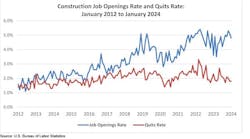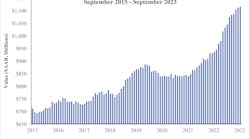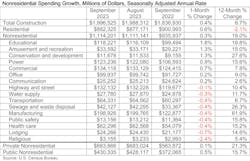PRESS RELEASES
WASHINGTON, Nov. 3 —The U.S. construction industry added 23,000 jobs in October, according to new data from the U.S. Bureau of Labor Statistics. On a year-over-year basis, industry employment has increased by 219,000 jobs, an increase of 2.8%.
Meanwhile, the U.S. Census Bureau reported Nov. 1 that nonresidential construction spending also increased 0.3% nationally in September. On a seasonally adjusted annualized basis, nonresidential spending totaled $1.1 trillion.
Spending was down on a monthly basis in 9 of the 16 nonresidential subcategories. Private nonresidential spending increased 0.1%, while public nonresidential construction spending was up 0.5% in September.
“Nonresidential construction spending increased for the 16th straight month in September,” said Anirban Basu, chief economist for Associated Builders and Contractors (ABC) trade group. “While some private categories, including power, commercial and amusement and recreation saw healthy month-over-month increases, publicly financed construction accounted for more than 72% of September’s rise. Given increased federal infrastructure spending and exorbitant financing costs for private construction, that dynamic should remain firmly in place over the coming months.”
Returning to the employment data, nonresidential construction employment increased by 8,400 positions on net, with growth in all three subcategories, Basu noted. Nonresidential specialty trade added 4,200 positions, while nonresidential building and heavy and civil engineering added 2,600 and 1,600 jobs, respectively.
Overall, the construction unemployment rate increased to 4.0% in October. Unemployment across all industries increased from 3.8% in September to 3.9% last month.
“The construction industry added jobs for the seventh consecutive month in October,” said Basu. “Over the past year, hiring has been concentrated in the nonresidential segment, with especially strong employment growth in the nonresidential building category. This is in large part due to the unprecedented surge in manufacturing megaprojects."
That surge in manufacturing work is also evident in the latest construction spending numbers.
“Despite a small decrease in spending in September, manufacturing construction remains the nonresidential sector’s outperformer,” added Basu. “Spending in the category is up 62% over the past year and accounts for nearly 43% of the year-over-year increase in nonresidential construction put in place. With several industrial megaprojects ongoing, spending in the manufacturing segment will remain elevated for several quarters.”
Looking ahead, over half of ABC member contractors recently surveyed intend to increase their staffing levels over the next six months and less than 7% intend to downsize, according to ABC’s Construction Confidence Index. Rising wages continue to add drama to an already tight labor market.
“While contractors’ demand for labor remains robust, the rising cost of labor, pushed upward by worker shortages, remains a pressing issue for the industry,” said Basu. “Average hourly earnings for construction workers increased at over twice the rate of economywide wages in October and have risen significantly faster over the past 12 months... Labor shortages should continue to push wages higher over the next few quarters,” he predicted.
##########











